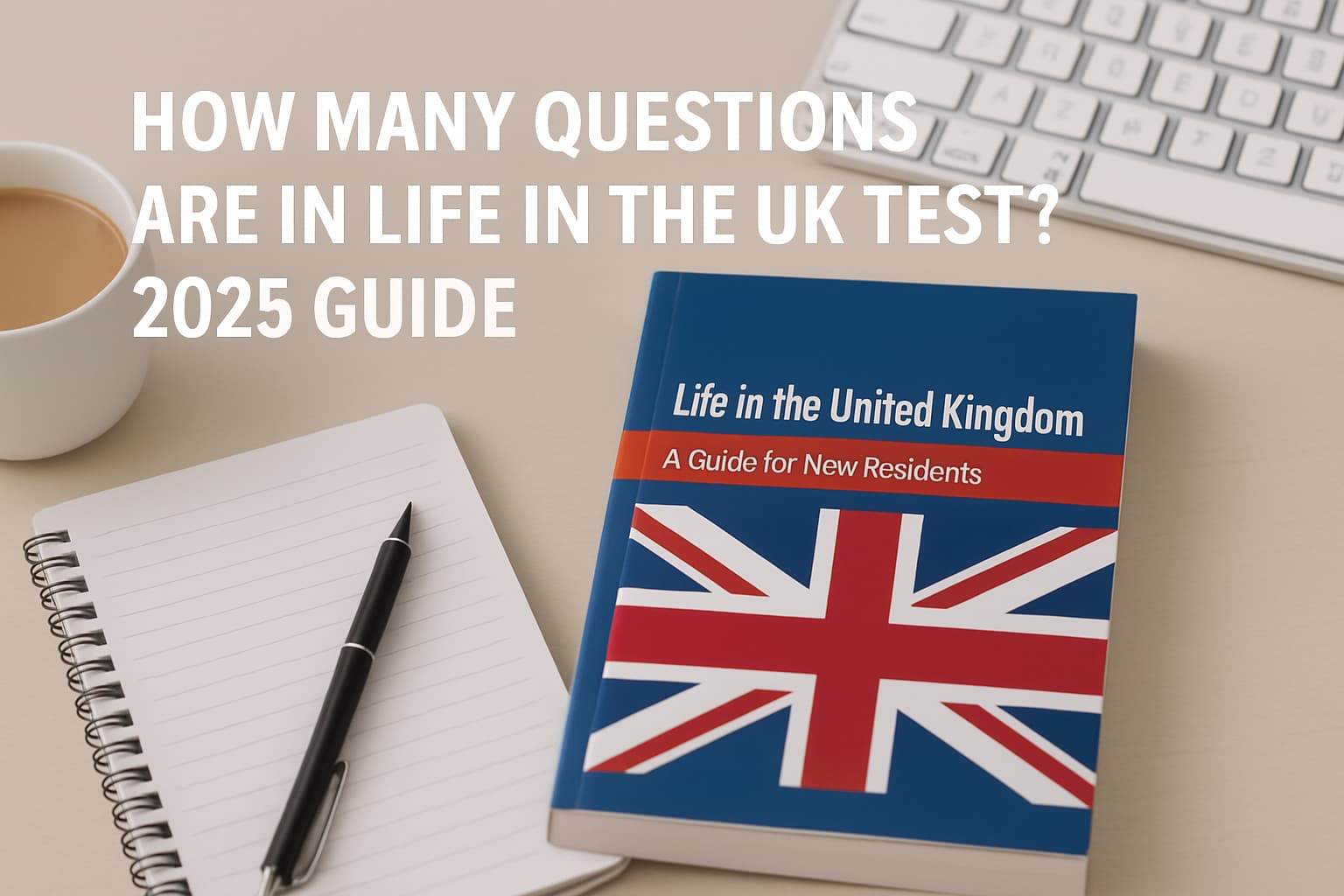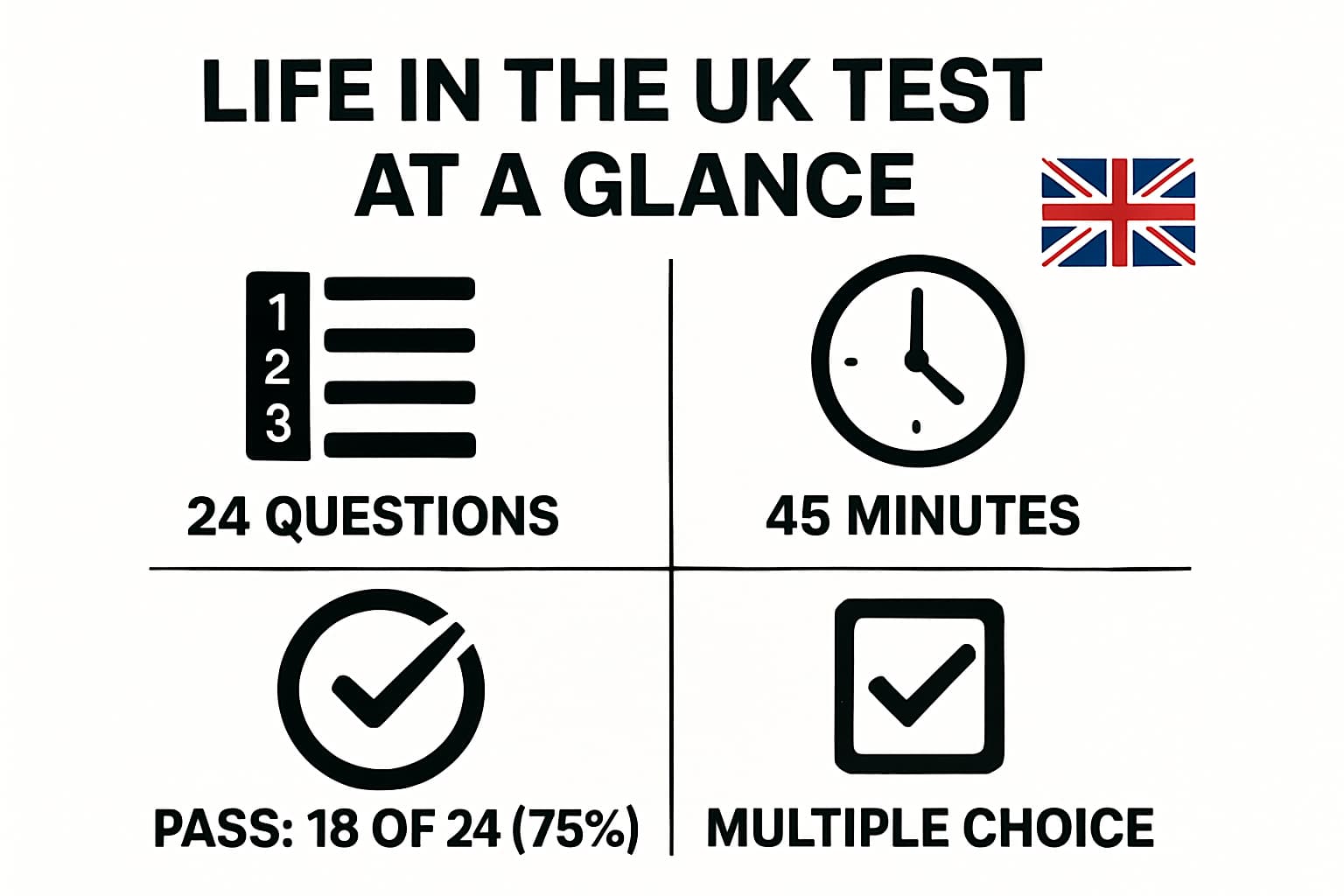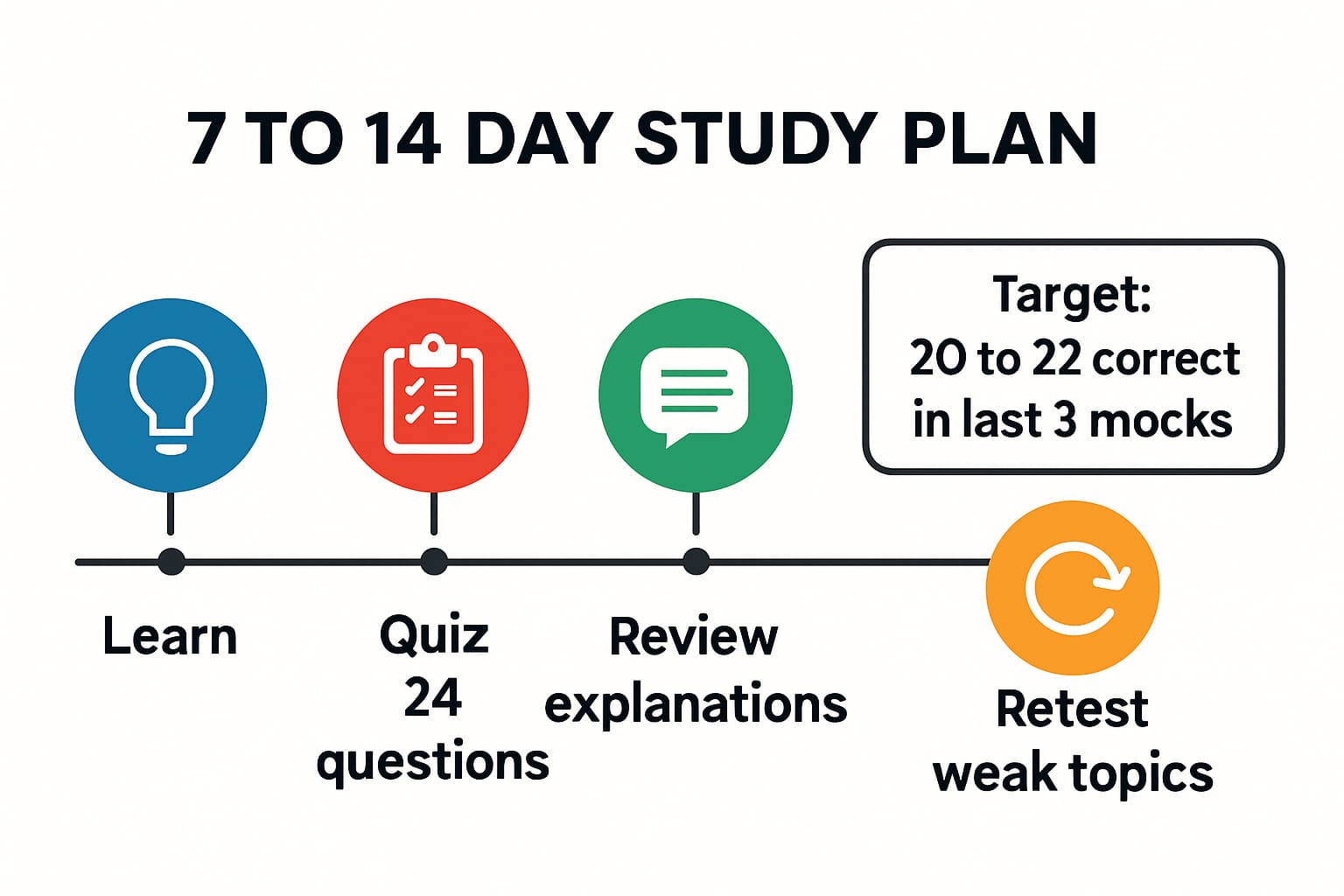How Many Questions Are in Life in the UK Test? 2025 Guide

Ready to book your Life in the UK Test but unsure about the exact format? Here is the definitive 2025 answer in under a minute, plus a simple plan to reach 18+ correct without time pressure.
This guide covers the official question count, pass mark, timing, realistic practice, a 7–14 day study plan, and how to use the Life in the UK Test App to pass on your first attempt.
Quick answer: How many questions are in Life in the UK Test?
Short version:
- Total questions: 24 multiple-choice
- Pass mark: 18 correct answers (75%)
- Time allowed: 45 minutes
- Average pacing: about 1 minute 52 seconds per question
- Applies to: both citizenship and ILR applications
These figures come directly from official guidance on GOV.UK and are consistent across 2025.
The exact number in 2025
If you are asking, how many questions are in Life in the UK Test? the official answer is 24 questions. This format is consistent whether you are taking the test for British citizenship or Indefinite Leave to Remain (ILR) (GOV.UK).
Pass mark explained: 18 out of 24 (75%)
You must score at least 18 out of 24 to pass, which equals 75% (GOV.UK). Put simply, you can miss up to 6 questions and still pass. This threshold is confirmed by multiple expert sources, including DavidsonMorris and Paragon Law.
Time allowed and pacing per question
You will have 45 minutes to answer all 24 questions (GOV.UK). That works out at around 1:52 per question. Plan to clear the easier questions quickly, then invest time in any tougher ones at the end.

What the 24-question format means for your strategy
The fixed 24-question format lets you build a predictable plan: secure the easy wins, protect your time, and carry a margin above 75%.
How many can you get wrong and still pass?
Up to 6 questions. That means you can focus on getting at least 18 correct without panicking over the occasional tricky item. If you finish with time to spare, return to any flagged questions for a final accuracy sweep.
Smart pacing: the 10-10-4 approach
- First 10 questions: 18–20 minutes. Build momentum on the straightforward items.
- Next 10 questions: 18–20 minutes. Maintain pace; flag anything that stalls you for later.
- Final 4 questions: Remaining time. Slow down, double-check wording, and confirm your best choices.
This split keeps you on track for the 45-minute limit while ensuring every question gets attention.
When to move on vs. when to double-check
- Move on if you are undecided after ~45–60 seconds. Make your best selection, flag it, and keep your rhythm.
- Double-check flagged items at the end, focusing on dates, names, and exceptions often found in the official handbook.
- Trust first instincts when evidence is even; needless changes can introduce errors.
Question format at a glance (and why it matters)
The exam uses multiple-choice questions that align directly with the Life in the United Kingdom: A Guide for New Residents handbook (3rd edition). Practising in the same format improves pacing, confidence, and recall under time pressure.
Multiple-choice questions drawn from the official syllabus
All questions are based on the official handbook content (overview) and Home Office guidance. If a fact is not in the handbook, it will not be tested.
Coverage areas you will see across 24 questions
- Values and principles of the UK
- UK history from early times to modern Britain
- Government and the law (institutions, voting, responsibilities)
- Culture and traditions (customs, landmarks, national days)
- Everyday life (education, healthcare, community)
These topic areas are reflected in reputable summaries of the test content (DavidsonMorris).
Real test vs. practice tests: why you may see 20, 24, or 30
Some practice quizzes use 20 or 30 questions to increase variety, but the real exam is always 24. Training with realistic 24-question mocks strengthens your pacing and reduces surprises on test day.
Always 24 on the day
The official exam length is 24 questions and 45 minutes, confirmed on GOV.UK. You will receive your pass/fail result on the day.
Why accurate 24-question mocks boost your pacing
- Time calibration: You learn what 45 minutes feels like across exactly 24 items.
- Confidence: Familiar structure lowers anxiety and speeds up decision-making.
- Result stability: Scores in realistic mocks better predict your real outcome.
Has the number changed for 2025? What the official guidance says
No change. The 24-question format remains in place for 2025. Always check the latest details directly on GOV.UK before you book.
Same format for citizenship and ILR
Both citizenship and ILR routes use the same test structure: 24 questions, 45 minutes, 18/24 to pass (Paragon Law).
Where to check for any future changes
- GOV.UK Life in the UK Test for booking, cost, and format
- Home Office Knowledge of Language and Life guidance for formal policy
- Independent legal overviews for test-day expectations and timelines
Study plan built around 24 questions
Here is a compact 7–14 day routine that fits busy schedules and builds you to 18+ correct, consistently.
Day-by-day: learn, quiz, review, repeat
- Learn targeted pages from the official handbook (focus on dates, names, institutions).
- Quiz with one realistic 24-question mock under a 45-minute timer.
- Review every explanation, not just the ones you missed; note weak topics.
- Retest weak areas the same day; next day, take a fresh 24-question mock.
- Repeat daily, spacing topics so tricky facts recur over multiple days.
Tip: Book the test once your last three mocks average 20–22 correct for a safe margin.

Benchmarking progress: hit 20–22 correct before booking
Aim above the minimum 18/24 to avoid retakes. The test costs £50 each time (GOV.UK), and if you fail, you must wait 7 days before booking again (DavidsonMorris). A higher practice score protects your wallet and your timeline.
Practice 24-question mocks with the Life in the UK Test App
Do not waste time on mismatched practice. The Life in the UK Test App mirrors the real exam so you can calibrate pacing and accuracy—without being overwhelmed by the handbook.
Realistic mocks, Hard Mode, and detailed explanations
- Real 24-question mocks with a 45-minute timer for exact exam conditions.
- Hard Mode to simulate pressure with tougher items drawn from a 650+ question bank.
- Step-by-step explanations to convert mistakes into points on your next attempt.
Micro-case: After a week of 24-question mocks, Amira moved from 16/24 to 22/24 by targeting repeated weak topics through explanations and Hard Mode. That is the compounding effect of structured practice.
Smart learning with Brit-Bear and offline study
- Brit-Bear, the in-app assistant, guides what to study next to avoid overload.
- Readiness score tracks your trend so you know when to book.
- Offline access means you can learn on the train, at lunch, or in short bursts.
Get started
Practice today with realistic 24-question mocks:
Quick FAQs about question count
Is it always 24 questions?
Yes. The official test has 24 multiple-choice questions in 45 minutes in 2025, per GOV.UK.
Is the number different for citizenship vs ILR?
No. Both routes use the same format: 24 questions, 18/24 to pass. Results are issued on the day.
Do practice tests with 30 questions reflect the real exam?
No. Only 24-question mocks match the real format. Longer sets can build knowledge, but use 24-question mocks for pacing.
How much time per question should I aim for?
Roughly 1 minute 52 seconds. Use a split like 10-10-4 across the 45 minutes to avoid rushing at the end.
What if I fail the test?
You can rebook after 7 days and must pay again (currently £50). See GOV.UK for the latest details.